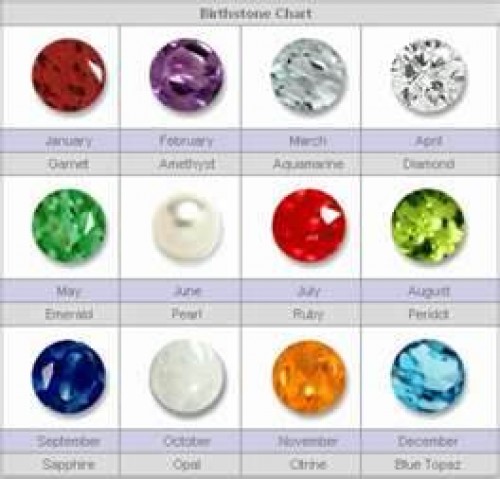What’s All This About Birthstones?
I have often wondered about birthstones, as they appear to be arbitrarily chosen and changed ever so often. While browsing the web I came across some interesting information that I retrieved from www.wikipedia.com that indicated the use of birthstones for many centuries, and is connected to the Gregorian Calendar. As was not surprising, the use of birthstones is tied to myth and lore, yet I wanted to share some of what I found as it includes poetry. I have had 3 different birthstones since I was born as they keep changing. Enjoy!!!
Birthstone Chart Many Decades Ago
Picture Credits: bloggers.com
Traditional Birthstones
Ancient traditional birthstones are society-based birthstones. The table below contains many stones which are popular choices, often reflecting Polish tradition.[10]
The Gregorian calendar has poems matching each month with its birthstone. These are traditional stones of English-speaking societies. Tiffany & Co. published these poems “of unknown author” for the first time in a pamphlet in 1870.[11]
By her who in this month (January) is born
No gem save garnets should be worn;
They will ensure her constancy,
True friendship, and fidelity.
The February-born shall find
Sincerity and peace of mind,
Freedom from passion and from care,
If they an amethyst will wear.
Who in this world of ours their eyes
In March first open shall be wise,
In days of peril firm and brave,
And wear a bloodstone to their grave.
She who from April dates her years,
Diamonds shall wear, lest bitter tears
For vain repentance flow; this stone,
Emblem of innocence, is known.
Who first beholds the light of day
In spring’s sweet flowery month of May
And wears an emerald all her life
Shall be a loved and happy wife.
Who comes with summer to this earth,
And owes to June her hour of birth,
With ring of agate on her hand
Can health, wealth, and long life command.
The glowing ruby shall adorn,
Those who in July are born;
Then they’ll be exempt and free
From love’s doubts and anxiety.
Wear a sardonyx or for thee,
No conjugal felicity;
The August-born without this stone,
`Tis said, must live unloved and lone.
A maiden born when September leaves
Are rustling in September’s breeze,
A sapphire on her brow should bind
`Twill cure diseases of the mind.
October’s child is born for woe,
And life’s vicissitudes must know,
But lay an opal on her breast,
And hope will lull those woes to rest.
Who first comes to this world below
With drear November’s fog and snow,
Should prize the topaz‘s amber hue,
Emblem of friends and lovers true.
If cold December gave you birth,
The month of snow and ice and mirth,
Place on your hand a turquoise blue;
Success will bless whate’er you do.—Gregorian Birthstone Poems
Modern Birthstones
In 1912, in an effort to standardize birthstones, the (American) National Association of Jewelers met in Kansas and officially adopted a list.[12] The Jewelry Industry Council of America updated the list in 1952[13] by adding alexandrite to June and citrine to November; specifying pink tourmaline for October; replacing December’s lapis with zircon; and switching the primary/alternate gems in March. The most recent change occurred in October of 2002, with the addition of tanzanite as a December birthstone.[14][15] Britain’s National Association of Goldsmiths created their own standardized list of birthstones in 1937.[16]
Birthstones by Cultures
Birthday (Day of the Week) Stones
While this word has also been used as synonym of Birth stone (see above), there is a separate list of assignment according to the day of the week of the recipient’s birth:[25]
-
Monday: pearl, crystal
-
Tuesday: ruby, emerald
-
Wednesday: amethyst, lodestone
-
Thursday: sapphire, carnelian
-
Friday: emerald, cat’s eye
-
Saturday: turquoise, diamond
-
Sunday: topaz, diamond
See also
External links
-
Jewelers of America leaflet
-
Curious Lore of Precious Stones, G.F. Kunz Full text online version
Charlene’s Source: Retrieved from “http://en.wikipedia.org/w/index.php?title=Birthstones&oldid=519382567“

